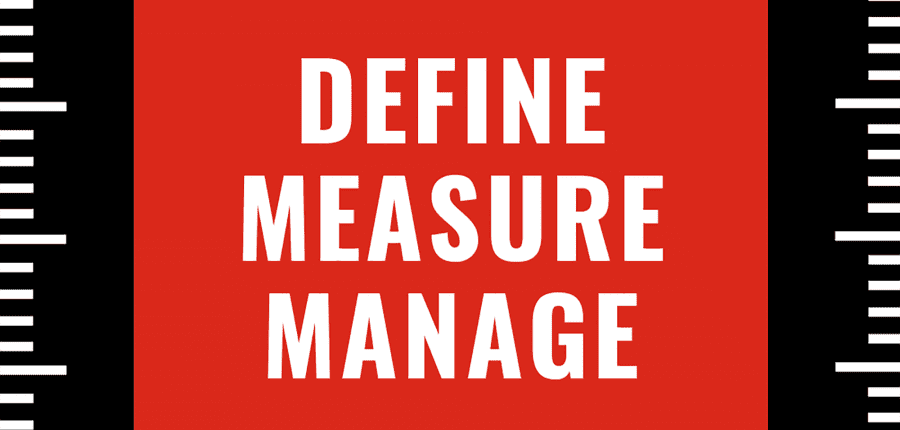
One of the key lessons I’ve learned in over twenty years of coaching is: If you can’t define it, you can’t measure it. If you can’t measure it, you can’t manage it. But what is “it”? What are the specific activities you, the CEO, should be tracking on company-wide scoreboards? And how are you going to get to the BIG outcome you want if you can’t lock these details down?
Quite simply, you’re not. So stop spinning your wheels and follow these four steps to definable, measurable, manageable metrics that will get you moving again. With the New Year fast approaching, now is the time to plan for next year’s success.
Where Did Define, Measure, Manage Come From?
You’ve probably heard the adage, “You can’t manage what you don’t measure.” It’s typically associated with Peter Drucker, a thought leader, author, and consultant. However, according to the Drucker Institute, Peter Drucker never coined this phrase, and his thoughts on measurement were quite complex. Drucker believed that measurement is important, but he did not hold the view that everything can be captured on a metric—including things like enthusiasm or someone’s alignment with a company’s mission.
Regardless, the phrase “You can’t manage what you don’t measure” holds a lot of power, which is crucial for CEOs and organizations to understand. Measuring key metrics can be extremely beneficial to a company’s growth and success, and if you measure to manage, you can find areas to improve.
Next, let’s explore what each of these actions means and what they look like in practice.
Define.
To manage what you measure, you first need to define what it is you’re looking to measure. Without a clear definition of what you’re trying to improve, you can find yourself heading down a path that leads to nowhere. To begin, think of author and inspirational leader Simon Sinek. One of Sinek’s most popular books is Start With Why, which is the first question you should ask yourself when embarking on your journey to improve your company’s growth.
Asking why will help you define what you’re trying to improve. For example, you could ask yourself:
- Why would someone want this product or service?
- Why is what I’m offering better than my competitors?
- Why are employees leaving or staying?
- Why has growth stalled?
Once you have a clear understanding of the issues you’re trying to solve, you can yield better results. This is because you’ll have a clear-cut benchmark of what’s holding your company back, whether it’s a lack of customer engagement, a decrease in revenue, declining sales numbers, or poor product performance.
With these issues defined, you can then make a plan to start measuring and managing. However, it’s essential that your entire team agrees on what it is that needs to be defined. As a CEO, you may have a skewed perception of some of the issues in your company. By getting your team involved, you’ll be able to get multiple perspectives on problems that need to be resolved.
Measure.
Now that you have your problem or issue defined, it’s time to measure. Remember, you can’t manage what you don’t measure, which is why this step is crucial. To begin measuring, you need to identify your key performance indicators (KPIs). A KPI is a performance measurement that can be used to evaluate the success of a business’s objectives. Some examples of KPIs include revenue growth, number of new contracts signed, lead conversion rates, and monthly website traffic.
Once your KPIs are identified, ask yourself if they’re growth-oriented. You want your KPIs to be backed by measurable data. Once you’ve determined the KPIs you’re trying to target, you’ll be able to formulate a plan for process improvement. This includes reanalyzing your Huge, Outrageous Target (HOT), which is the goal you set for yourself the moment you became the CEO. By measuring KPIs and creating a plan to improve the processes that directly impact these KPIs, you’ll be on track to reach your HOT.
As you measure, you also want to look at how you stack up against your competition. While no two businesses are alike, it’s important to know how others in your industry are performing, so you can determine whether you’re lagging behind or one step ahead. With a clear understanding of how your competition is performing, you’ll have examples to base your measurements on to see your growth.
Manage.
As a CEO, it’s important you manage what you measure. Managing is crucial to ensuring you stay on track to accomplishing your goals. Measuring can only go so far, but management will allow you to accomplish your HOT.
There are several factors you need to manage during this process of improving the performance of your company. The first is expectations. It’s easy to dream big and expect immediate results. But growth is a waiting game and doesn’t happen overnight. Keep your team’s expectations reasonable, so you can take actionable steps to achieve your goals without losing focus.
The next key step to managing is issuing progress reports. You can measure all you want, but if the results aren’t compiled into a clear report, it’s hard to see whether you’re moving forward or backward. Progress reports can take many forms, with reports on milestones coming every week or every few weeks, and reports on larger goals coming monthly or quarterly.
Another factor to manage is expenses. As a CEO, it’s your duty to ensure your company remains profitable. With that said, it can be easy for projects to get out of hand and put a dent in your bottom line. Along the way, make sure to continually monitor expenses to ensure the changes you’re making are valuable investments in the company.
Lastly, you’ll want to manage any pivots you may need to make. At the beginning of your journey, it can be easy to overlook potential roadblocks, and some situations are unavoidable. A key component to being a successful CEO and running a business is being adaptable. Pivoting when obstacles arise can ensure you continue on a straight trajectory to meeting your goals.
How To Improve the Performance of Your Company
Now that you know you can’t manage what you don’t measure, it’s time to learn how to improve the performance of your company. Take a look at the four steps to put define, measure, and manage into practice below.
1. Refocus on your HOT.
When struggling CEOs can’t tell me what key metrics they’re tracking, there’s usually not one reason for this potentially fatal lack of clarity. More often than not, there are a bunch of nagging problems that are obscuring the CEO’s original vision. These distractions might result from chasing after shiny new objects, scattershot planning, a sense of complacency, or plain old panic.
Time to clear your desk and get back to basics. Forget about the latest trend. Forget about what your competitors are doing and how they’re doing it. Forget about flinging every desperate idea you have at the wall until something sticks.
Instead, think about why you’re the CEO of this company in the first place. What is that Huge, Outrageous Target (HOT) you set once upon a time that, for whatever reason, you’ve lost sight of? Why are you climbing the mountain, and what’s the view going to look like when you get to the top?
For CEO Coaching International client Rich Balot, the HOT was $1 billion in sales. For Grasshopper, the HOT was mastering their core competency in virtual voicemail. For TaskUs, the HOT was to be a global leader in outsourcing.
Three Huge, Outrageous Targets hit by three companies that had the courage to think BIG and the discipline to focus on those targets above all else.
2. Identify your killer metrics.
No two companies are the same. But all successful companies know that the difference between staying stuck in neutral and shifting into high gear is managing the killer metrics that are most tied to growth.
Take Grasshopper. After asking themselves some very challenging questions, they determined that growing as a SaaS company depended on their customer acquisition cost, churn rate, average revenue per user, and the lifetime value of each client.
Everything Grasshopper did to raise its valuation north of $170 million was based around measuring and improving these killer metrics. They did vigorous market testing. They scrapped initiatives that weren’t working and refocused their resources on those that drove up the growth rate. And they brought in triple-A talent who kept driving that growth and pushed the company up to the next level.
3. Break “it” down.
If you’re selling a product, your killer metric might be sales to new customers, cost per lead, or lowering your product return rate. A service company might focus on the revenue that each employee generates.
Those are good metrics. But the crucial next step is where most struggling companies keep tripping over themselves. “I’m going to sell to new customers” or “I’m going to get more clients” are not actionable activities that you can track and measure every day, every week, every month, every quarter. You have to break down that goal by asking yourself a simple but powerful question: How? What are the systems and processes you have in place that will drive up those killer metrics, and your company’s growth?
Let’s say you’ve determined that new clients are your killer metric. Acquiring X new clients per quarter will lead you to your year-end growth target. That’s a good start.
Now, ask yourself, “How am I going to acquire X clients this quarter?” This might lead you to compare the relationship between how many prospect meetings you have per quarter and how many of those meetings lead to new clients.
OK, then, “How do I get more prospect meetings?” You might look at how many meetings you get per hundred mailers you send out, or how many phone calls your sales team has to make.
Now we’re getting somewhere! Sales calls per day, per month, per quarter. Mailers sent. Email campaigns started. These are actionable steps that you can plaster on a big scoreboard. These are small, workable tasks you can track, measure, and manage. . These are the things your company needs to achieve in the short term in order to grow BIG long term.
Monitor your cash.
There is one key metric that applies to any business of any size: cash.
A good CEO should be obsessive about cash. That means making sure you’ve done everything you can to shorten your cash operating cycle so you’re getting paid as quickly as possible and monitoring cash levels like your daily cash balance and cash flow.
All the defined tasks that you measure and manage should be keeping you profitable and growing. If they’re not, then what good are they? You might need to circle back to step one. Or better yet, schedule an annual planning session that will shake off some cobwebs and recalibrate your focus on the right metrics, the best processes, and the clearest path to BIG.
About CEO Coaching International
CEO Coaching International works with CEOs and their leadership teams to achieve extraordinary results quarter after quarter, year after year. Known globally for its success in coaching growth-focused entrepreneurs to meaningful exits, the firm has coached more than 1,500+ CEOs and entrepreneurs across 100+ industries and 60 countries. Its coaches—former CEOs, presidents, and executives—have led businesses ranging from startups to over $10 billion, driving double-digit sales and profit growth, many culminating in eight, nine, or ten-figure exits.
Companies that have worked with CEO Coaching International for two years or more have achieved an average revenue CAGR of 25.9%, nearly 3X the U.S. average, and an average EBITDA CAGR of 39.2%, more than 4X the national benchmark.
Discover how coaching can transform your leadership journey at ceocoachinginternational.com.
Learn more about executive coaching | Meet our world-class coaches





